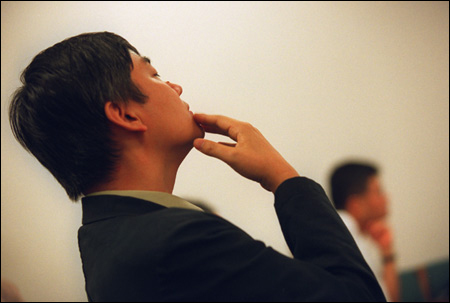Economist details North Korean plight
Collapsing industry devastated North Korean industrial agriculture

North Korea’s long-running food shortage is a crisis of the nation’s own making that is hitting nonelite city residents hard and, without a leadership change, shows no sign of stopping.
“I don’t think you can solve the food situation in North Korea, the human rights abuses … under the current regime,” Marcus Noland, senior fellow at the Institute for International Economics in Washington, D.C., told a gathering at the Asia Center Friday (Nov. 7). “I think otherwise [without leadership change], you have an ugly continuation of the status quo.”
Under that status quo, though the worst of the famine is over, North Koreans are still hungry, with a large share of their food coming from international aid, Noland said. Estimates of the dead from the mid-1990s famine range from 250,000 – by the North Korean government – to several million. Noland’s own estimate falls between 600,000 and 1 million dead.
A hungry history
The problem has deep roots, going back to the years after the Korean War, Noland said in his talk, “Famine and Reform in North Korea,” which is part of the Modern Asia Series and co-sponsored by the Asia Center and the Korea Institute.

During that time, traditional farms were collectivized and the nation adopted modern industrial agricultural practices. These practices require the use of industrial products, such as chemical fertilizers, pesticides, and farming and irrigation machinery.
Though the nation experienced periodic food shortages about once a decade, the deeper troubles started in the late 1980s, when the USSR, which had provided North Korea with substantial aid over the years, demanded repayment of some of that aid. Then, when the USSR and the Soviet bloc crumbled in 1991, North Korea lost its major trade partners and its industrial economy collapsed, Noland said.
The failure of North Korea’s industrial economy cut off the flow of essential items from farms, Noland said.
‘The straw that broke the camel’s back, I would argue, is the cutoff of Chinese aid.’
– Marcus Noland, Senior Fellow at the Institute for International Economics in Washington, D.C.
Though there is a disparity between food production figures from North Korean and other sources, these sources agree that food production dropped in the late 1980s and through the 1990s. Early in the crisis, Noland said, farmers made up for the drop in production from their fields due to the lack of fertilizer and pesticides by planting more land. This led to cutting trees on hillsides and other marginal areas, setting the nation up for disaster in the 1995 floods.
Noland, co-author of “Avoiding the Apocalypse: The Future of the Two Koreas,” said the straw that broke the camel’s back may have come from China. As the North Korean situation worsened in 1990, China stepped in with a rapid increase in aid. That aid stopped abruptly, however, in 1993.
“The straw that broke the camel’s back, I would argue, is the cutoff of Chinese aid,” Noland said.
Other international sources stepped in subsequently, but Noland said the food crisis continues today. Distribution of domestic and donated food goes to the nation’s elite and to the military first. That leaves the rest of the nation potentially hungry, but because people in rural areas can grow enough to feed themselves, the brunt of the shortage falls on the urban population outside the nation’s elite, Noland said.
Reform, but not enough
In recent years, North Korean leaders have announced a series of economic reforms, but Noland said he doesn’t believe they will go far enough to pull the country out of the crisis. The situation, he said, is deeply rooted in the structure of the nation’s agricultural and economic system and will not be easy to resolve.
Noland said he believes North Korea has to abandon its national goal of agricultural self-sufficiency and adopt a course of industrializing to produce goods for export. Money from those exported goods could then be used to import the food North Korea needs.
North Korea’s northerly latitude and high population compared with its amount of arable land mean it isn’t the most ideal place to grow a lot of food. When combined with its comparatively literate and skilled population available to work in industrial settings, the way seems clear, Noland said.
The nation’s leadership stands in the way, however. With power concentrated in the hands of Kim Jong Il, the army, and a small number of people around Kim Jong Il, Noland said he didn’t see the nation changing course anytime soon.
Further, with China, South Korea, and Japan worried about the nation’s stability, Noland believes North Korea will receive enough food and other aid to forestall a serious challenge to the nation’s leadership.
“At any point in time, one of them [China, South Korea, or Japan] will keep them alive,” Noland said. “I think they’ll just muddle through.”




